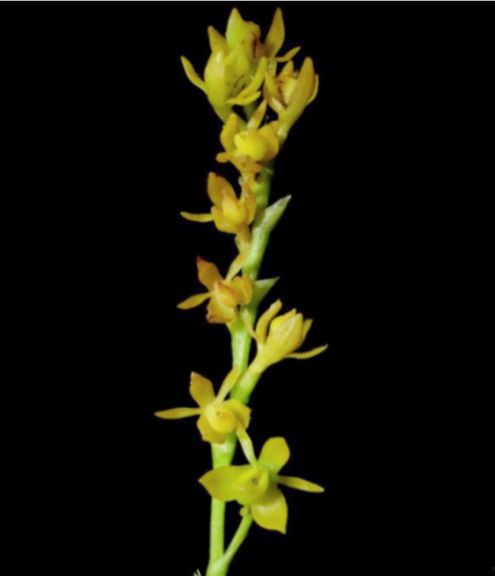

Epidendrum dendrobioides Thunb. 1818 GROUP Aquaticum
Photo by D de Freitas/ drawing by R. Jiménez M. © courtesy of Eric Hagsater and The AMO Herbario Website
Photo by © Christian Hu



Common Name The Dendrobium-Like Epidendrum
Flower Size .6" [1.5 cm]
Found only in central to southern Brazil in the Planalto Brasileiro and the Mata Atlântica, at elevations 1000 to 1750 meters as a medium to large sized, cool growing terrestrial with a canelike, branching, terete at base, somewhat laterally compressed towards the apex, straight; primary stem 9.2 to 24" [ca. 23-60 cm] long, stem branches carrying 13 to 20 on the primary stem, 6 to 8 on the branches; distributed throughout the stems, articulate, distichous, coriaceous, rigid, sub-erect with respect to the stems; sheaths tubular, striated, blade linear-lanceolate, dorsally carinate, acute, margin entire, somewhat revolute when dry leaves that blooms in the spring on a terminal, without a spathe, apical, flowering only once, erect, distichous, simple to rarely producing a single branch, laxly few-flowered; peduncle .12" [3 mm] long, sub-terete; rachis .29 to .48" [5.7 to 12.2 mm] long, 2.4 to 5" [6 to 12.5 cm] long overall, slightly sinuous, 6 to 20 flowered inflorescence with , triangular to triangular-ovate, acuminate floral bracts.
Hagsater in 2018 reworked the GROUP Aquaticum and found that E dendrobioides was restricted to Brazil when previously it had ranged from Trinidad south through the Guyanan sheild and into Brazil.
"Epidendrum dendrobioides belongs to the GROUP Aquaticum which is characterized by the monopodial, branching habit, the distichous, erect to arching-nutant inflorescence, with fleshy flowers, and the disc of the lip and/or nectary often pilose. The species is recognized by the linear-lanceolate, acute leaves 1.4 to 2.4" x .02 to .32" [3.5 to 6 x 0.5 to 0.8 cm]; inflorescence generally distichous, simple, laxly few-flowered, flowers yellow, sepals .24 to .3 x 1.08 to 1.48" [6.0 to 7.5 x 2.7 to 3.8 mm], petals linear-oblong, .22 to .24" x .4 to .48" [5.5 to 6.0 x 1.0 to 1.2 mm], the lip shallowly 3-lobed, base cuneate, with a small triangular mid-lobe, disc with an entire callus, apically bilobed. Epidendrum carnosum Lindl. has lanceolate leaves 1.6 to 3.46" x .24 to .52" [4.0 to 8.6 x 0.6 to 1.3 cm], inflorescence generally paniculate and many-flowered, the branches all sub-erect, flowers pale yellow to greenish yellow, sepals .36 to .4" x .16 to .2" [9 to 10 x 4 to 5 mm], petals lanceolate-rhombic, .32 to .36" x .056 to .1" [8 to 9 x 1.5 to 2.5 mm]; lip clearly 3-lobed, base truncate, disc with a bidentate callus. Epidendrum pseudavicula Kraenzl. has smaller plants, 2.8 to 8" [7 to 20 cm] tall, leaves ovate to oblong-lanceolate, apex rounded, .4 to 1.4 {.32]" x .24 y .4" {.72}" [1.0 to 3.5 [8.0] x 0.6 to 1.0 {1.8} cm], flowers greenish yellow, sepals .2 to .24" x .064 to .1" [5 to 6 x 1.6 to 2.5 mm], petals .2 to .213" x .03 to .032" [5.0 to 5.3 x 0.75 to 0.8 mm], the lip clearly 3-lobed, bicallose with a mid-rib in between the calli. Epidendrum aquaticum Lindl. has similar sized plants, but the leaves are lanceolate, .52 to 2.04" x .16 to .24" [1.3 to 5.1 x 0.4 to 0.6 cm], flower green, sepals ca. .2" [5 mm] long, and the lip with the base truncate. Epidendrum durum Lindl. has lanceolate to ovate-lanceolate leaves .8 to 2.2" x .2 to .56" [2.0 to 5.5 x 0.5 to 1.4 cm], a generally paniculate inflorescence, the branches spreading perpendicular to the main, erect rachis, flowers greenish white, petals linear-elliptic, and the disc of the lip with a “V” shaped callus." Hagsater etal 2018
Synonyms Epidendrum aquaticum Lindl. 1843; Epidendrum carnosum var. nutans Cogn. 1898; Epidendrum durum var. parviflorum Lindl. 1853;
References W3 Tropicos, Kew Monocot list , IPNI ; Symbolae Antillanae Vol VI Orchidaceae Urban 1909 as Epidendrum urbanianum; Flora of the Lesser Antilles Garay & Sweet 1974 drawing fide; Orchidaceae Brasiliense Band 1 Pabst & Dungs 1975 drawing hmm; Venezuelan Orchids Illustrated Vol 6 Dunsterville & Garay 1976 not = D ulei;Die Orchideen 3 Auflage Bd 1 Sonderabdruck aus Schlechter Lieferung 9 513 - 576 Brieger, Maatsch and Senghas 1977; AOS Bulletin Vol 48 No 3 1979 photo as E montigenum; Orchids of Venezuela, An Illustrated Field Guide Vol 1 Dunsterville & Garay 1979 drawing not = E ulei ; Orchids of Venezuela, Orchids of Venezuela An Illustrated Field Guide Vol 1 Dunsterville & Garay 1979 as E montigenum drawing fide; Icones Orchidacearum Peruviarum Plate 238 Bennett & Christenson 1995 as E alsum drawing fide; Orchidaceae Antillanae Nir 2000; Flora of the Venezuelan Guayana Vol 7 Steyermark, Berry, Yatskievych and Holst 2003 as Epidendrum durum; Flora of the Venezuelan Guayana Vol 7 Steyermark, Berry, Yatskievych and Holst 2003 as E urbanianum; Orchids of The Brazilian Central Plateau Menezes 2004 photo fide; Orquideas Da Chapada Diamantina Brito & Cribb 2005 photo/drawing fide; Icones Orchidacearum 8 Plate 875 Hagsater 2006 see recognition section; The Organ Mountain Range Its History and its Orchids Miller, Warren, Miller & Seehawer 2008 drawing fide; Orquideas de Roirama Luz & Franco 2012 photo fide; Orchidees du Bresil As Orquideas da Serra Do Castello Vol 3 Chiron & Bolsanello 2013 Drawing/photo fide; Orquideas, Tesoro de Colombia Vol 2 Ortiz & Uribe 2017; Icones Orchidacearum 16[1] Plate 1602 Hagsater & Santiago 2018 See recognition section; Icones Orchidacearum 16[1] Plate 1604 Hagsater & Santiago 2018 See recognition section; Icones Orchidacearum 16[1] Plate 1608 Hagsater & Santiago 2018 See recognition section; Icones Orchidacearum 16[1] Plate 1614 Hagsater etal 2018 drawing/photo fide; Icones Orchidacearum 16[1] Plate 1649 Hagsater & Sanchez 2018 see recognition section; Icones Orchidacearum 16[1] Plate 1664 Hagsater & Sanchez 2018 See recognition section;
--------------------------------------------------------------------------------------------------------------------------